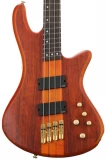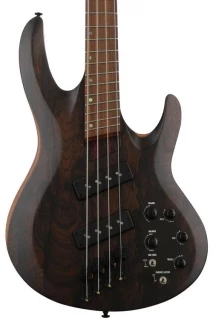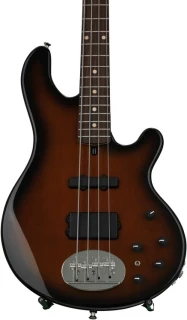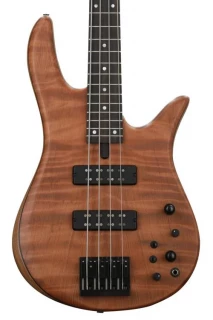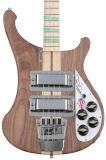Schecter Stiletto Studio 4 FF - Honey Satin Review
Featured Deal
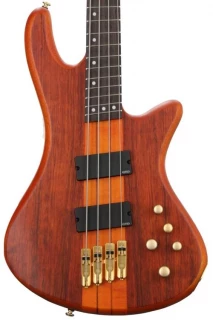
From $1062.00
Get DealSchecter Stiletto Studio 4 FF - Honey Satin
4-string Electric Bass with Mahogany Body, Bubinga Top, Maple/Walnut Neck, Multi-scale Rosewood Fingerboard, 2 Humbucking Pickups, and Active EQ - Honey Satin
$1,099.00
$769.30
$989.10
Schecter Stiletto Studio 4 FF - Honey Satin For Sale
Most Popular 4-string Bass Guitars
G&L Tribute Fallout Short Scale Left-handed
4-string Electric Bass Guitar, Left-handed, with Poplar Body, Hard Rock Maple Neck,... read more
ESP LTD B-1004 Multi-Scale
4-string Electric Bass with Ziricote Top, Swamp Ash Body, 5-piece Wenge/Purpleheart Neck,... read more
Lakland USA Classic 44-14
4-string Electric Bass Guitar with Alder Body, Maple Neck, and Rosewood Fingerboard... read more
Yin Yang 4 Standard Purpleheart
4-string Electric Bass with Alder Body and Purpleheart Top, Maple Neck and... read more
Fodera Monarch 4 Standard Special
4-string Electric Bass Guitar with Walnut Body, Flamed Redwood top, Maple Neck,... read more
Specifications |
|||
|---|---|---|---|
| Brand | Schecter | ||
| Category | 4-string Bass Guitars | ||
| Number of Strings: | 4, | ||
| Left-/Right-handed: | Right-handed, | ||
| Body Shape: | Stiletto, | ||
| Body Material: | Mahogany, | ||
| Body Finish: | Satin Polyurethane, | ||
| Color: | Honey Satin, | ||
| Neck Material: | Maple/Walnut Multi-ply, | ||
| Neck Shape: | Thin C, | ||
| Radius: | 16", | ||
| Fingerboard Material: | Rosewood, | ||
| Fingerboard Inlay: | Offset dots, | ||
| Number of Frets: | 24, Extra Jumbo, | ||
| Scale Length: | 34"-35" Multi-scale, | ||
| Nut Width: | 1.496", | ||
| Nut Material: | Black Tusq, | ||
| Bridge/Tailpiece: | S-Tek Top-loaded Bridge, | ||
| Tuners: | Schecter, | ||
| Neck Pickup: | EMG 35HZ Humbucker, | ||
| Bridge Pickup: | EMG 35HZ Humbucker, | ||
| Controls: | 1 x master volume, 1 x blend, 3-band Active EQ, | ||
| Strings: | Ernie Ball Super Long, .045-.105, | ||
| Manufacturer Part Number: | 2793, | ||
Daily Deals
Schecter Stiletto Studio 4 FF - Honey Satin Reviews
Schecter Stiletto Studio-4 FF review
Schecter Stiletto Studio-4 FF review The good: This is a nice bass. It's my third Schecter, and like the others, it plays very well and has the potential for being set up with really low, slap friendly action. As it comes set up from the factory, the action is respectably low and probably fine for most bass players. The EMG pickups sounds great, and the grain pattern on the body… read more top is quite lovely. The fanned frets are certainly eye-catching, and the variable scale concept works exactly as intended. I have read many comments from bass players as to how it only takes a single session of playing to get used to, but my experience was a little bit different; it took me exactly zero minutes to get used to the funhouse looking fretboard. If you dig the variable scale concept, you should not be frightened away from trying such an instrument; the transition is quite natural, and 40 years of professional bass playing produced exactly no retroactive interference in handling this bass. The bad: This bass comes strung from the factory with standard tuning for a four string bass, E-A-D-G, and this is stupid. A standard long neck (34" scale) bass produces about the ideal tension (to my feel and ear) for the E and A strings; there is no need to tighten the E string, and doing so does not really do anything to improve action, and just makes the string slightly harder to play because of the increased tension and longer reach. It's probably a benefit if you keep the base tuned with a low D string, but I was not going for that (read below if this review is not already too long). The bridge is essentially made of cheese. My first Schecter has a similar monorail bridge, though slightly beefier. Don't get me wrong, this is a perfectly functional bridge, it's just not the kind of spring-loaded-screw-adjustable-intonation bridge with which most people will be familiar. It's also made out of pretty thin metal, which is my main beef as far as quality goes. But the real atrocity here is the limited dimension of adjustment allowed by the bridge as it comes from the factory. As mentioned above, the action is respectable, but the fine neck on this bass will allow the action to be lowered significantly more than the dimensions of adjustment to the bridge will allow. When it comes to action, I am always looking for bragging rights, and this guitar did not cough up the goods. Fortunately, I am a pretty good amateur Luthier and general shop monkey. Rating for most bass players who want to just buy off the shelf and play: 4 out of 5 stars How I made this bass great: After playing the factory stock bass for about a week, I ripped the whole thing apart, etched and blacked all the hardware (I hated the gold), tore off the bridge sleds and saddles, and ground 2 mm off of the base of each of the eight parts. This increased the dimension of action adjustment by 4mm south. Eureka! Now I could crank the action down low enough to contact the frets at tension as a starting point, and make full use of that wonderful neck in my quest to make the instrument play like a stick of butter (I performed the exact same operation on my first Schecter 4 string when I bought it back in 2001). While I had everything taken apart, I filed out the nut and saddles enough to accommodate the gauges 130-105-85-65. That is a five string bass string set, less the G string, for B-E-A-D tuning. When I reassemble the whole deal, I was able to set the action @ 1 mm (actually slightly less by my feeler gauge) above the fret 12 on the B string, that action being maintained through the fret 24 because of the wonderful neck on this bass! To be fair, this absurdly low action is not for everyone; it takes a light touch to play cleanly without an amplifier, but I have been honing my playing technique for a long time, and this is perfect for me. I am also fond of producing metallic piano sounds by intentionally slapping the strings against frets, and this kind of setup is made to do just that. Having played this thing for a while now, I will make these observations about the fanned frets. The low strings are definitely less flappy. I have been playing BEAD tuning for almost 10 years using modified 34 inch scale four string basses (I do not want to wrestle with the wide neck of a five string bass). I have never been able to get the action on those basses this low for lack of tension on the B string. If you do want to use this nonstandard tuning, keep in mind that playability is not dependent upon action alone; increased tension on strings makes them require more force to fret at any given action, and even though the action might be a tiny bit higher on my 34 inch B-E-A-D basses, they are still slightly easier to play, partly because of the tension thing, and partly because that extra inch of scale necessitates a noticeably greater finger stretch down low. Having said all of that, I love this bass! There is a certain robust feel to the bigass neck that is just not there with my 34" BEAD basses, and it looks extra cool when I am playing it. It is actually almost an inch longer overall than my 35" scale 5 string (that I have not played in years). I custom made a coffin case for it that is actually my smallest case, so tight is the fit, and that looks extra cool, too! (Photos of all attached) Rating from me after I modified the bass as described: 5 out of 5 stars
Love it
I bought a Stiletto with the fan frets about 6 weeks ago and love it. Incredible warm tone, super easy to play, and the fanned frets were very easy to get used to. A great bass. I use especially for both funk slap style and jazz gigs, The EQ is great, the hardware top notch. And man does this thing stay in tune, even through the cold weather. I like the balance on my shoulder--easier… read more than a P or Jazz bass to keep in position for good technique. And the Bubinga top is beautiful. Def. get the Schecter Case to go with it. Awesome case worth the money to protect this piece of artwork. The only downside is getting used to the extra long neck. I have good technique but reaching into the lower positions sometimes causes a little trouble in my wrist. Would definitely recommend and buy again.
Schecter Stiletto Studio 4 FF - Honey Satin Questions and Answers
No Questions Yet.



